Who is she?
Yayoi Kusama is a Japanese contemporary artist who works primarily in sculpture and installation, and she is also active in painting, performance, video art, fashion, poetry, fiction, and other arts.
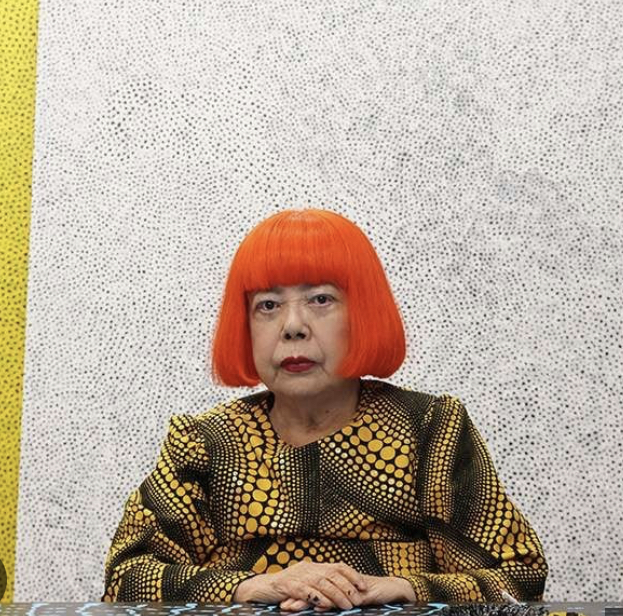
Her work is based in conceptual art and shows some attributes of feminism, minimalism, surrealism, art brut, pop art and abstract expressionism and is infused with autobiographical, psychological and sexual content. She has been acknowledged as one of the most important living artists to come out of Japan, the world’s top-selling female artist, and the world’s most successful living artist. She was inspired by American Abstract Impressionism.
Embracing the rise of the hippie counter culture of the late 1960’s she came to public attention when she organized a series of happenings in which naked participants were painted with brightly coloured polka dots She experienced a period in the 1970s during which her work was largely forgotten, but a revival of interest in the 1980s brought her art back into public view. Kusama has continued to create art in various museums around the world, from the 1950s through the 2020s.
Kusama has been open about her mental health and has resided since the 1970s in a mental health facility. She says that art has become her way to express her mental problems.
“I fight pain, anxiety, and fear every day, and the only method I have found that relieved my illness is to keep creating art”
When Kusama was ten years old, she began to experience vivid hallucinations which she has described as “flashes of light, auras, or dense fields of dots”. These hallucinations included flowers that spoke to Kusama, and patterns in fabric that she stared at coming to life, multiplying, and engulfing or expunging her, a process which she has carried into her artistic career and which she calls “self-obliteration”. Kusama’s art became her escape from her family and her own mind when she began to have hallucinations. She was reportedly fascinated by the smooth white stones covering the bed of the river near her family home, which she cites as another of the seminal influences behind her lasting fixation on dots. Her artwork is often linked to these experiences, reflecting on her own inspirations.
“I followed the thread of art and somehow discovered a path that would allow me to live.”
Moodboard:

Why I chose Yayoi Kusama
Yayoi Kusama is a renowned Japanese artist whose work has had an influence on feminism and fashion, through her contributions are often indirect or conceptual. Kusama’s art intersects with feminism through her exportation of the body, identity especially and gender, while her influence within fashion can express her visual language, specifically her iconic and memorizing polka dots, embodying self expression, rebellion against norms and empowerment. Kusuma’s fashion and art not only challenges conventional and typical beauty standards but also highlighting women within culture and art.
One thing that stood out it me, to keep my project linking ever so slightly to feminism, meanwhile having a variety is her theme reflecting on rebellion against norms. She does this through her unique expressions through the abstract and colourful clothing choices and back drops of her images such as, this image below.
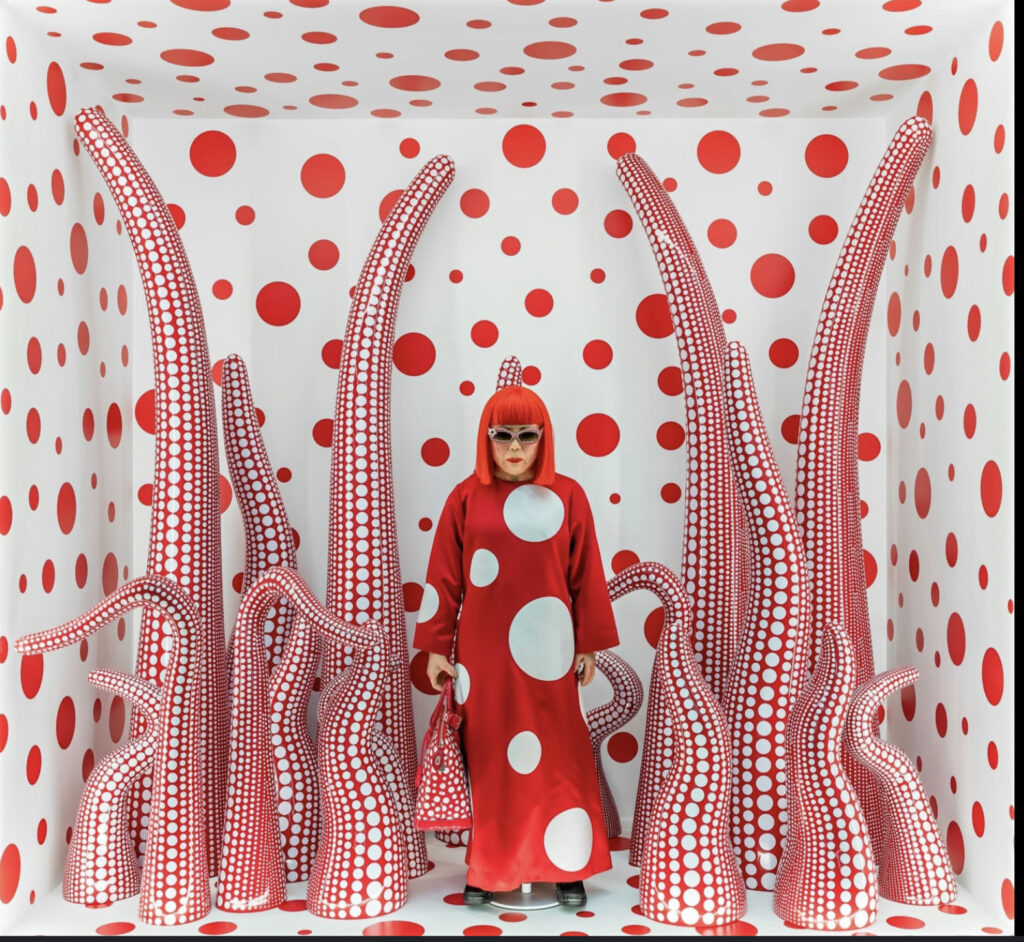
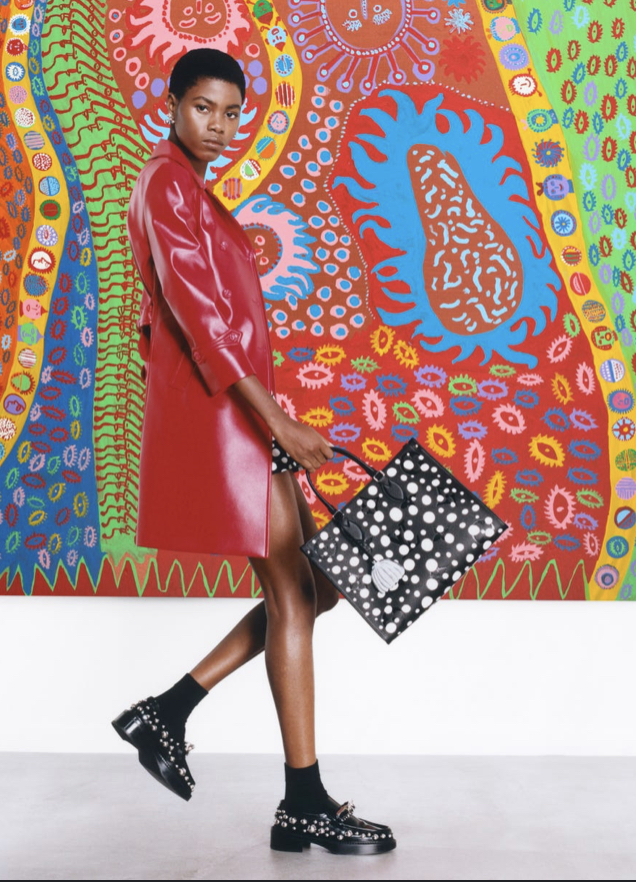
Her work links to her mental health and psychological issues, expressing identity and differences within individuals. Her public struggles, link to Nan Goldin’s linking to my previous study. I find this evident through her psychedelic perspective shown through her fashion expression. Feminist critics often read this as a critique of how women are treated in a world that silences their voices and suppresses their emotional realities. Her race and ethnic unique style contributes to her art within culture.
Kusama has explored sexuality and the body in her work, often using her body as the expression, challenging the norm of objectification and de-humanizing within women surrounding sexual identity. Her ‘accumulation’ series where everything surrounding her and her body in polka dots can be seen as self- expression that challenges societal norms about women’s bodies and the expectations they face in society. My most previous project and essay, argued that expectations and social norms can be seen to be made by men as we live in a patriarchal society, however there is also the belief that stereotypes and social standards are a social norm and are inevitable. Therefore, this links to my previous project surrounding stereotypes, but from a different perspective with different and unique contributes.
Kusama’s fashion influence is often seen to be very bold and confident. She does this through her polka dots and vibrant colours making it difficult for viewers to not be interested. The polka dot eventually became Kusama’s signature symbol of femininity. It has become symbolic for breaking free from conventional and idealised expectations in society. This therefore influences empowering women through visual identity, Kusama’s approach to fashion and art reinforced the perspective that women should not only embrace their bodies but also express themselves bodily through fashion.
This ultimately lead to collaborations with fashion brands such as Kusama’s partnership with Louis Vuitton in 2012 making a wider audience for her art and fashion. Her iconic and unique yet memorizing symbols lead to wearable accessories partnering with Louis Vuitton creating a fusion of art, fashion and feminism.
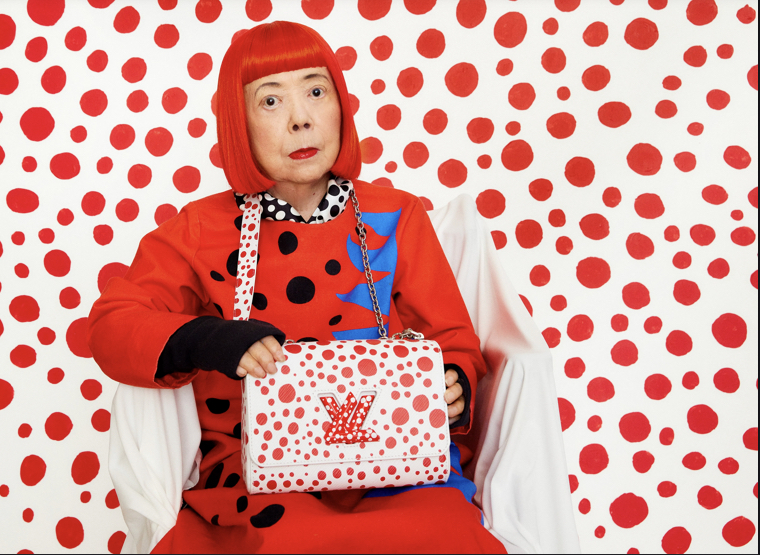
Image Analysis
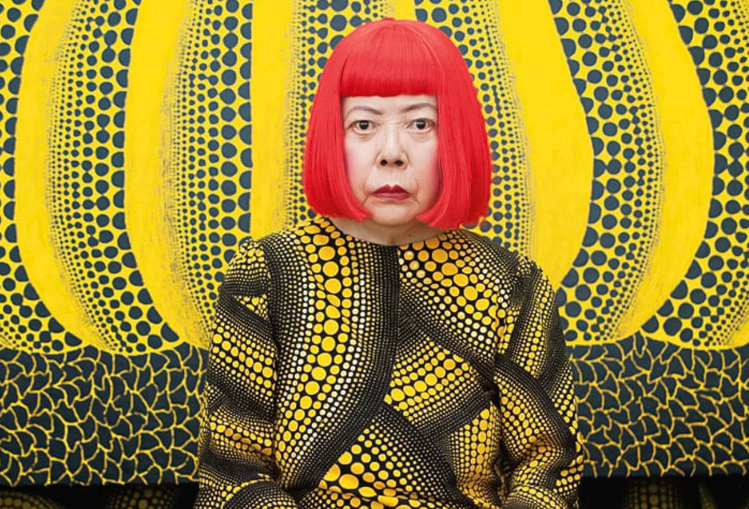
Firstly, the most eye catching element that draws my attention is the polka dots, however in a very different format and pattern. Her clothing matches to the back drop through colour, but contrasts through different layout and pattern within the small circles. She does this as she is emphasizing infinite patterns and the concept of infinity. Kusuma is famously obsessed with the element of infinity, which she symbolizes frequently. By blending her own attire with the backdrop, she is expressing her potential psychological states. Kusuma also plays with ideas of identity and gender through this technique. This form could be seen as a self-erasure, where she isn’t making herself and individuality. Instead, she becomes the physical environment challenging the idea of a fixed identity. The clothing looks like a type of animal skin potentially snake. Her unique style, patterns and vibrant colours is definitely eye catching. Most importantly, Kusuma uses her self, as a subject in her art, to explore the themes of femininity, identity and obsession. Her use of her own body as her art, serves as both a personal and universal expression of her own life and experience, especially her struggles of mental health, particularly her struggles with OCD and hallucinations. By using her own body as a canvas, she creates a direct and intimate collaboration between herself and the world. The covering her body, through patterns, symbolizes her desire to erase the boundaries and expectations between herself, and society. The bold, repetitive patterns are not just a form of self expression but a way of merging her persona with her art. This expresses as a way to reinforce her identity in a larger cultural context and make her own personal narrative and experience her own creative expression. This image, is taken from a dead pan angle and style. Her expressions are very neutral, and does not obtain a dramatic perspective or excessive visual flair. This is because the subject, appears impassive, unaffected and looking direct at the camera. The lighting is more soft, to allow the colours to be much more vibrant, as the colours are very significant in these type of images as it is her type of expression in her images to signify her traditional culture.
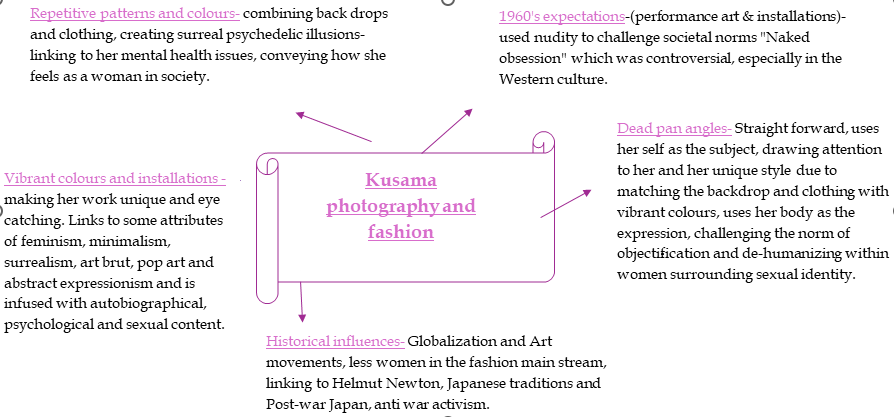
Historical Context
Kusuma’s own life and career challenge traditional gender roles. She moved to New York in the 1950’s, a time when the art world was dominated by male figures such as Jackson Pollock and Andy Warhol. She faced an element of sexism, but Kusuma’s refusal to conform to expectations made her an emblematic figure for women fighting for their place in the art world. Her boldness, resilience and unique aspect were later recognised as a feminist struggle for equality in the art world.
Her art blends with traditional Japanese aesthetics with contemporary practices, often reflects on japan’s complex history. Kusuma’s work, particularly her early work, emerged in the post-war period. This era in Joan had an influence on Western culture and a shift in social and cultural values. This links to her photo shoots obtaining nudity in the 1960’s. She used nudity to explore and challenge societal norms. She often used her own body as a medium such as “ Naked obsession” or “Body Festivals” which both included her use of expression through polka dots to cover the themes of sexuality and identity. The nudity was meant to break down the barriers between the artist and the audience and to challenge controversial modesty, sexuality and the female body. This was seen as highly controversial especially in the 1960’s in the main stream Western culture. The period was marked by shifting social attitudes towards sexuality, specifically during the sexual revolution. Kusuma’s work was seen as provocative and radical, as it went against the traditional expectations and stereotypes for how women should portray themselves in art.
The influence on Japanese traditions such as Kusama’s use of patterns, particularly her iconic and signature polka dots, connects to historical elements such as the kimono design in textiles. This link reflects her heritage and identity.
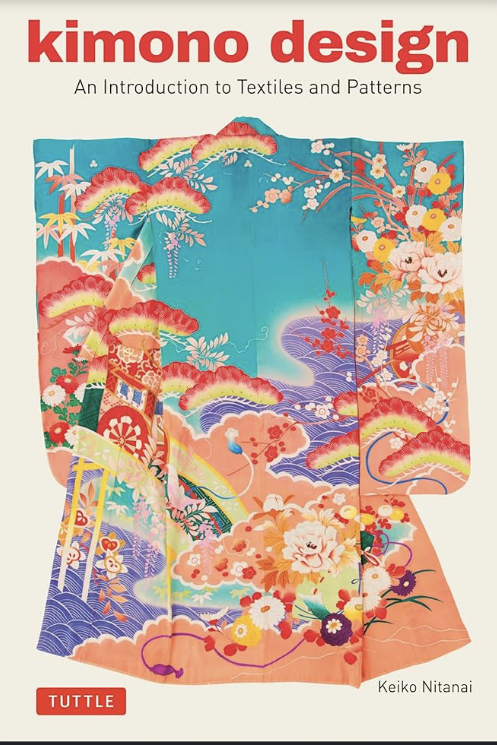
Psychological and social reflections in Kusuma’s work especially her use of infinity nets, installations and polka dots, reference themes of isolation, infinity and psychological states. This can link to her mental health issues such as OCD and hallucinations or even trauma, potentially post- war anxieties and the ever- changing field of fashion.
Overall why I decided to study Kusama and linking to union
Overall, I decided to study Kusama as she focuses on how it feels to be a woman and identity. But most importantly, rebels against the societal norms shown through her use of nudity in the 1960’s. This links to union as women as a whole within a political sense fought and rebelled through these standards and expectations to become something. This links slightly to my previous project however I focused on stereotypes. Kusama inspires me to make my project on union focusing on how women rebel through fashion specifically. Kusama clearly did this through symbols and her own experiences leading to empowerment. Fashion is stereotypically seem as more feminine as women tend to enjoy it more. Therefore, I aim to make a photo shoot linking to Kusama by making my own symbols aswell as fashion that ultimately signifies rebellion and identity and power roles within social norms within women through boldness and resilience. Kusuma deeply engages with her exploration on a personal and conceptual level. By using her body in her art, often without the conventional constraints of gender or modesty, Kusuma asserts her autonomy with her artistic practices. Ultimately challenging sexual expression. She also links to union through her heritage such as her Japanese Western traditions. She shows this through her modernist styles such as abstract expressionism and minimalism. Contributing to her Japanese culture. Kusuma presented herself as vulnerable, powerful and bold. The use of nudity became a tool for Kusuma to explore why and how female bodies were often objectified and over- sexualised.
